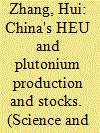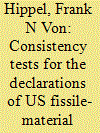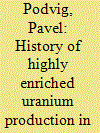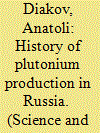| Srl | Item |
| 1 |
ID:
104162


|
|
|
|
|
| Publication |
2011.
|
| Summary/Abstract |
This article discusses the history of China's production of highly enriched uranium and plutonium for nuclear weapons and uses new public information to estimate the amount of highly enriched uranium and plutonium China produced at its two gaseous diffusion plants and two plutonium production complexes. The new estimates in this article are that China produced 20 ± 4 tons of HEU, 2 ± 0.5 tons of plutonium, and currently has stockpiles of about 16 ± 4 tons of HEU and 1.8 ± 0.5 tons of plutonium available for weapons. The values for China's fissile material production are at the low end of most previous independent estimates, which range from 17-26 tons of highly enriched uranium and 2.1-6.6 tons of plutonium. These new estimates would be significant to assess China's willingness to join a fissile material cutoff treaty and a multilateral nuclear disarmament.
|
|
|
|
|
|
|
|
|
|
|
|
|
|
|
|
| 2 |
ID:
104158


|
|
|
|
|
| Publication |
2011.
|
| Summary/Abstract |
In the 1970s and early 1980s, the United States Government released data on the history of its purchases of natural uranium, the amount of separative work done by U.S. uranium enrichment plants, and the fission energy released by U.S. production reactors. These data provided the basis of nongovernmental estimates in the 1980s of U.S. production of plutonium and highly enriched uranium. In 1996 and 2006, the United States published reports on its historical production of plutonium and highly enriched uranium respectively. This article presents a first rough analysis of the two sets of data and finds that they are reasonably consistent.
|
|
|
|
|
|
|
|
|
|
|
|
|
|
|
|
| 3 |
ID:
104161


|
|
|
| 4 |
ID:
104160


|
|
|
|
|
| Publication |
2011.
|
| Summary/Abstract |
For almost 50 years, the production and processing of weapon fissile materials was the primary mission of the Soviet nuclear complex. The cloak of secrecy on all nuclear weapons activities was lifted in 1995. However, the Soviet Union did not declare the amount of fissile-material that it produced for military purposes, and Russia did not reconsider the release of this information. Non-governmental analysts have made estimates of Russia's stocks of weapon-grade plutonium based on assumptions about the power history of the production rectors but such estimates are uncertain. This article attempts to provide improved estimates of production and current holding of weapons plutonium in Russia based on recent publications of historical documents and memoirs on the design and operation of the production reactors.
|
|
|
|
|
|
|
|
|
|
|
|
|
|
|
|
| 5 |
ID:
104159


|
|
|
|
|
| Publication |
2011.
|
| Summary/Abstract |
The amount of plutonium discarded as wastes from the U.S. nuclear weapons complex appears to be significantly greater than the U.S. Department of Energy's 1996 declaration of its plutonium holdings. This is due to in part to improved radioactive waste characterization and the disposal of plutonium residues originally intended for use in weapons. The Hanford site in Washington State has the largest quantity of plutonium wastes, which pose potentially serious human risks to ground water and the near shore the Columbia River. The department should revise its accounting for plutonium, and take steps to remove plutonium discarded to the environment at Hanford, as it is required to do at Idaho National Laboratory.
|
|
|
|
|
|
|
|
|
|
|
|
|
|
|
|